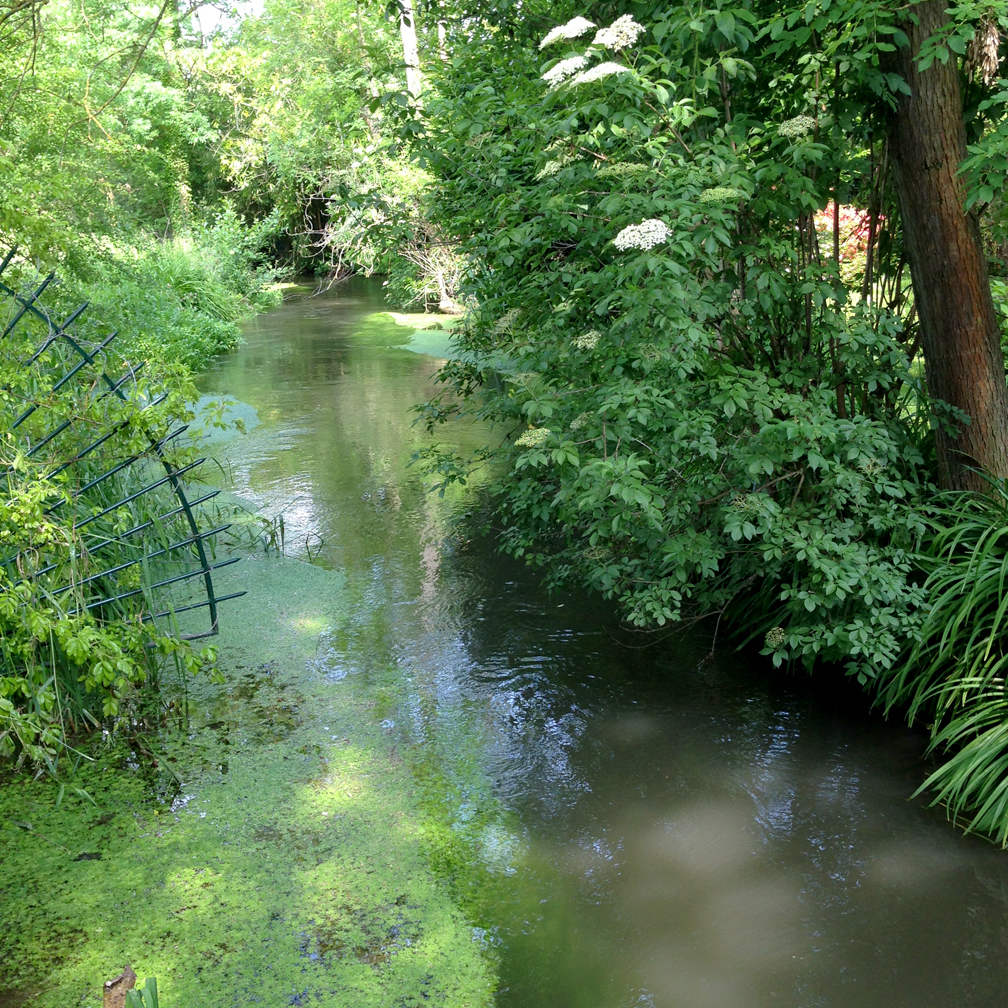Giverny Impressions
On my many trips to Paris over the years, I have always avoided a visit to the famous Monet site at Giverny. Last week I finally bit the bullet and got myself on an early train from Gare St. Lazare bound for Vernon.
As I was riding the bus shuttle from the Vernon station to the Monet house and gardens, my previous refusal to come to Giverny made perfect sense. The experience was combining so many things I dislike: the deification of dead artists, the hordes of selfie-taking tourists, the BB King blues medley blasting from the bus speakers...
Streaming lemming-like with my fellow bus passengers into the small town of Giverny, I consoled myself by looking forward to seeing Monet's studio, which he had built to work on his huge "Nympheas" canvasses.
It didn't help my mood to discover that the studio had been turned into a very large gift shop. Next we were channeled into the legendary flower gardens, designed and maintained by Monet himself, and his muse for the last great efforts of his painting life.
Click on any image to enlarge.
Once I stepped out the studio door, it took about two minutes to tune out the hundreds of people close around me, and fall under the spell of Giverny.
What I first noticed was the scale. Monet's gardens are big, overflowing, excessive in a wonderful way, like a summer lunch of delicious course after course that never seems to end.
Always in the background, leading up and out of this expanse of color and shapes, is a little bit of pale sky, or the faint blue of a distant hill.
Monet's home also provides a backdrop, adding a simple geometric contrast to the organic curves of trees, shrubs and arbors.
The house's pink walls and green shutters soften and blend into the surrounding garden.
The next thing I noticed was the almost messiness of the garden, a mish-mash style of inter-planting that bordered on unkempt.
It struck me as more of an English cottage-style way of planting, rather than the typical formal French aesthetic.
As a gardener myself, who often feels depressed about the ungroomed state of my perennial beds, I found this approach of "non-persnickety profusion" quite liberating...
Clean gravel paths and green metal trellises provide some man-made structure to all of this organic chaos.
Colors in the garden are as inter-mixed as the dense plantings, creating a rich hodge-podge palette both subtle and bright.
I wandered quite awhile through these exuberant flower beds before remembering that Monet's famous lily pond was here, too.
It's separated from the main property by a 20th century road, but I tried not to let my grumpy spirit creep back in, and, with only a thought or two about the tyranny of the automobile, walked through a short tunnel.
On the other side I was rewarded by a whole new feeling, the peace of being by a stream in the woods, in a place both natural and designed.
Such an unusual and lovely blending of art and nature.
A simple edging of branches defined the stream, a trellis provided a delicate focal point, daylilies and iris gave a touch of active color to a restful range of greens.
I could see here the inspiration for Monet's paintings of water.
They often explore reflections, the reality/unreality of a surface that shows us both what is there, and what is not there.
And then there were was the water lily pond that Monet featured in his last great series of paintings.
The actual pond, with its famous Japanese bridge, is quite modest in size and scope. Comparing it to the complex, monumental Nympheas paintings reminds us how much imagination artists, including landscape painters, bring to their work.
I decided to join the crowd one more time and take a look inside Monet's home.
I felt like an intruder walking through the bedroom where the artist died, but the rest of the house warmed my heart.
The cobalt and turquoise kitchen, with its huge wood stove and deep farm sink, was made for cooking on as grand a scale as Monet's paintings.
And I couldn't look at the bright yellow dining room, hung all over with the Japanese prints that so influenced Impressionist composition, and not feel happy.
One last view out the window to the bright gardens and blue hills beyond reminded me why so many people, from all over the world, flock here to Giverny as if it were a shrine.
We all want some beauty in our life, some independence, and some peace. This place that Monet built plant by plant and brick by brick over many years, on land he first spotted from a train window, reminds us how risk, hard work, and vision can be rewarded.
Spending a little time here creates a hope that each of us, in our own way, can cultivate a garden and create a home.
Click on my photographs to enlarge.
Your comments are welcome below! Please feel free to leave your name and website address.
